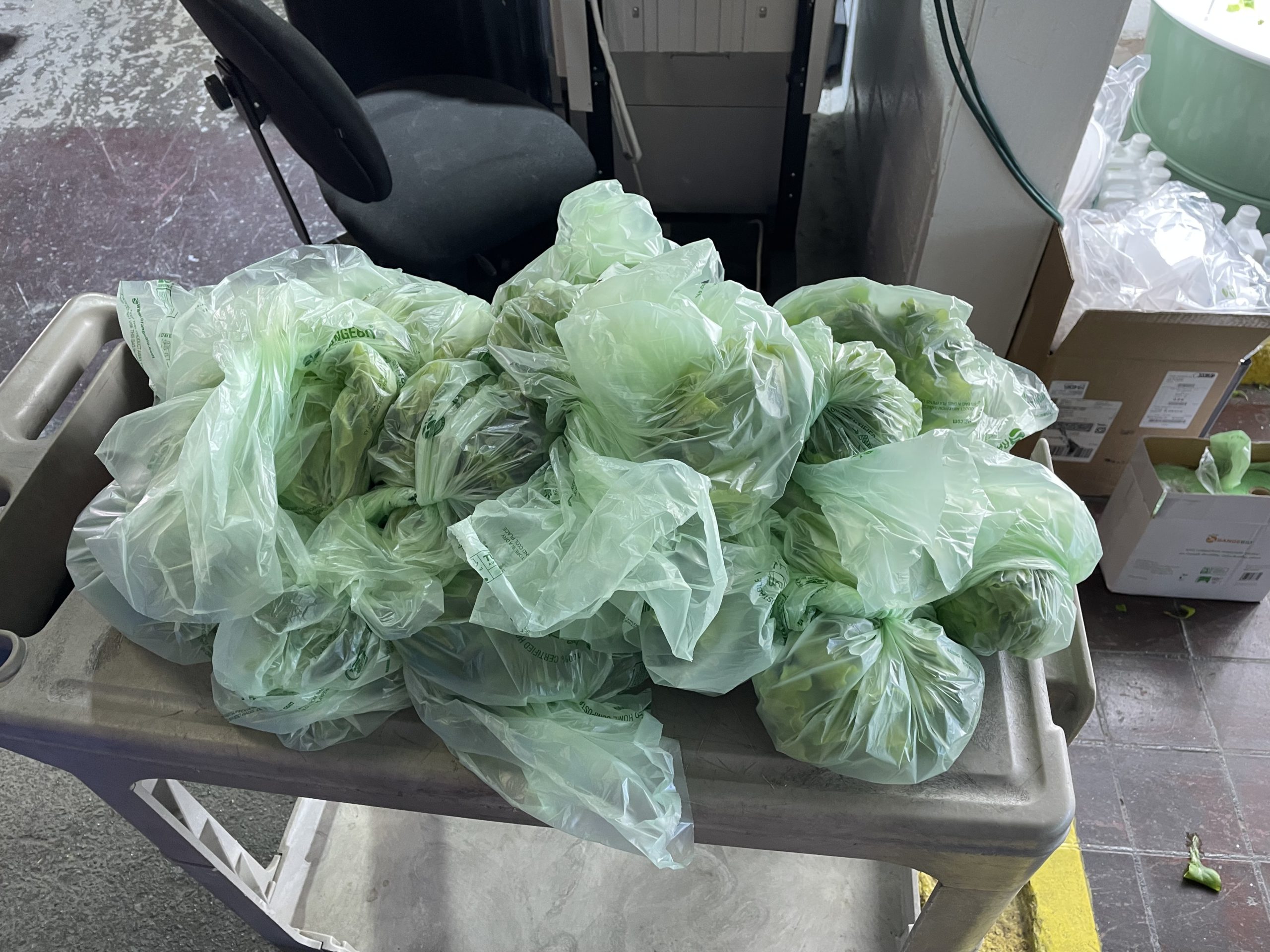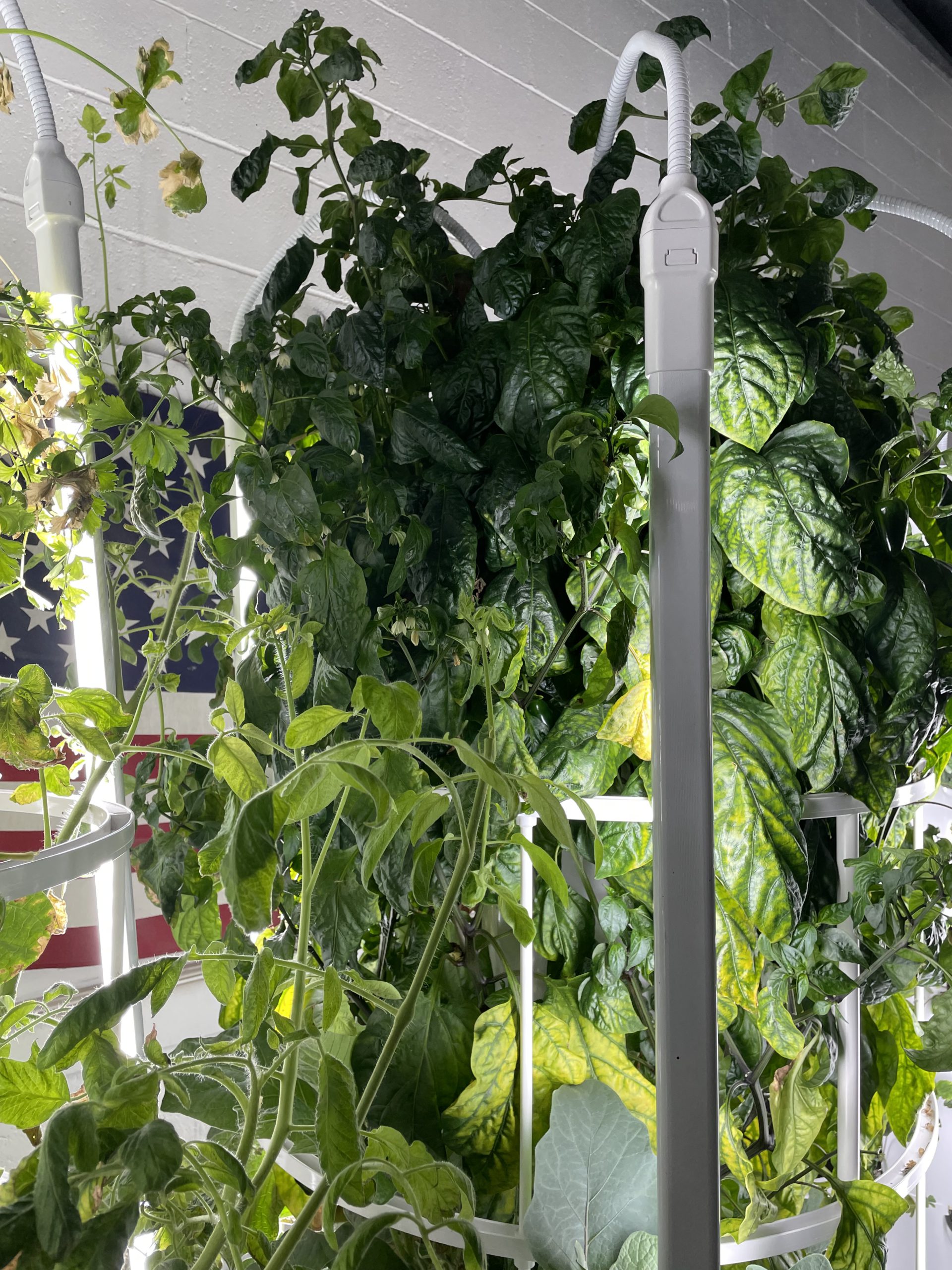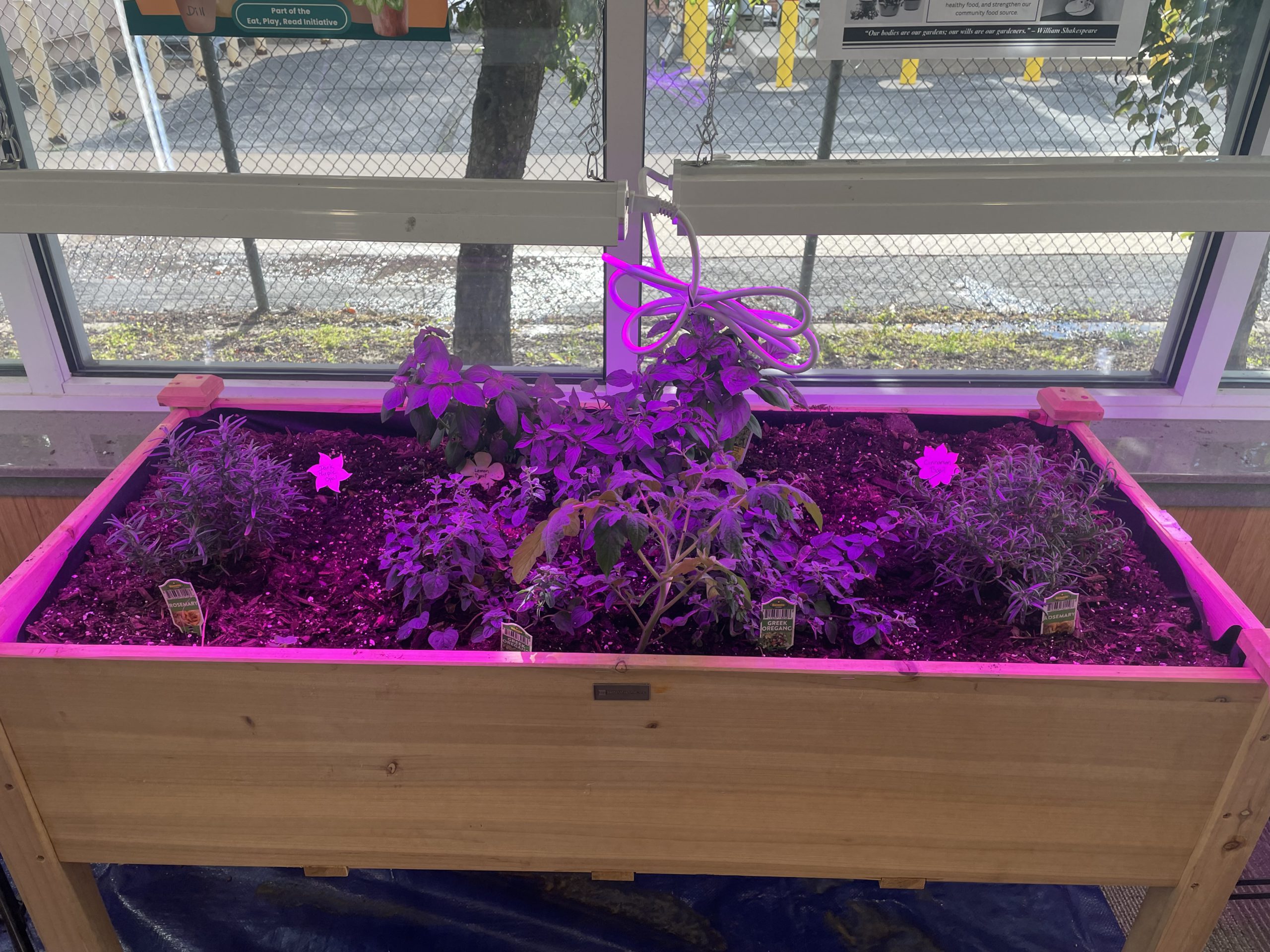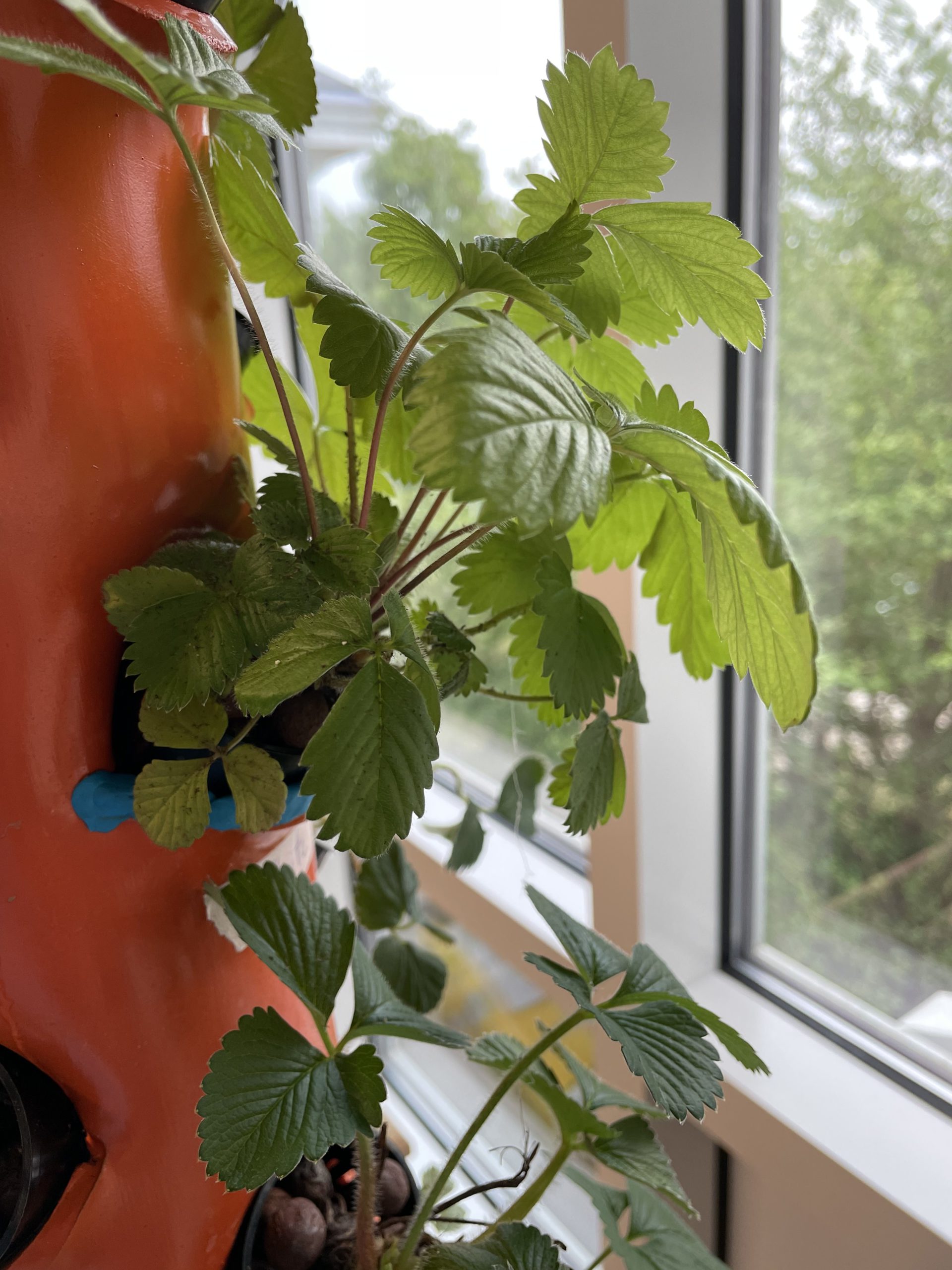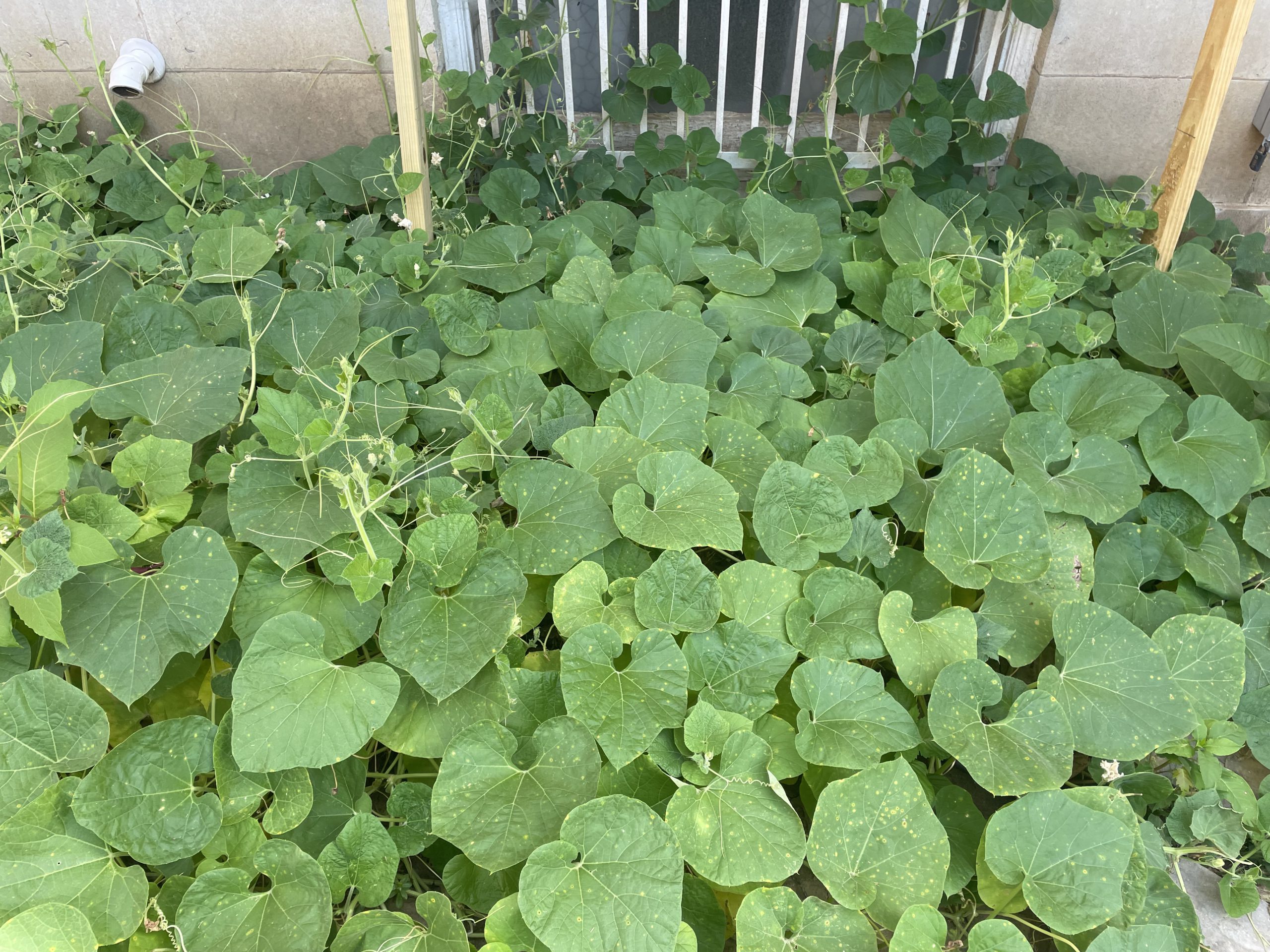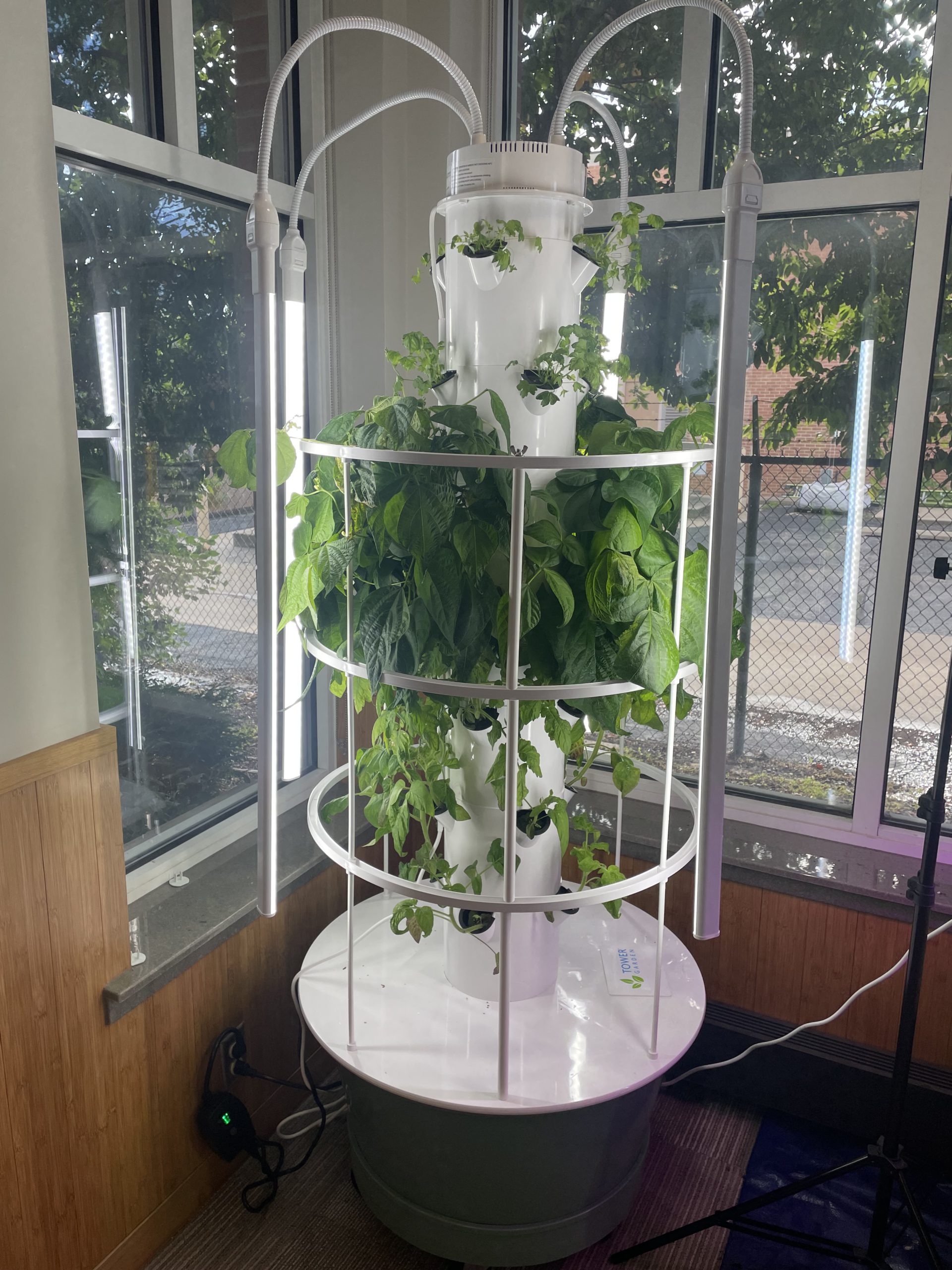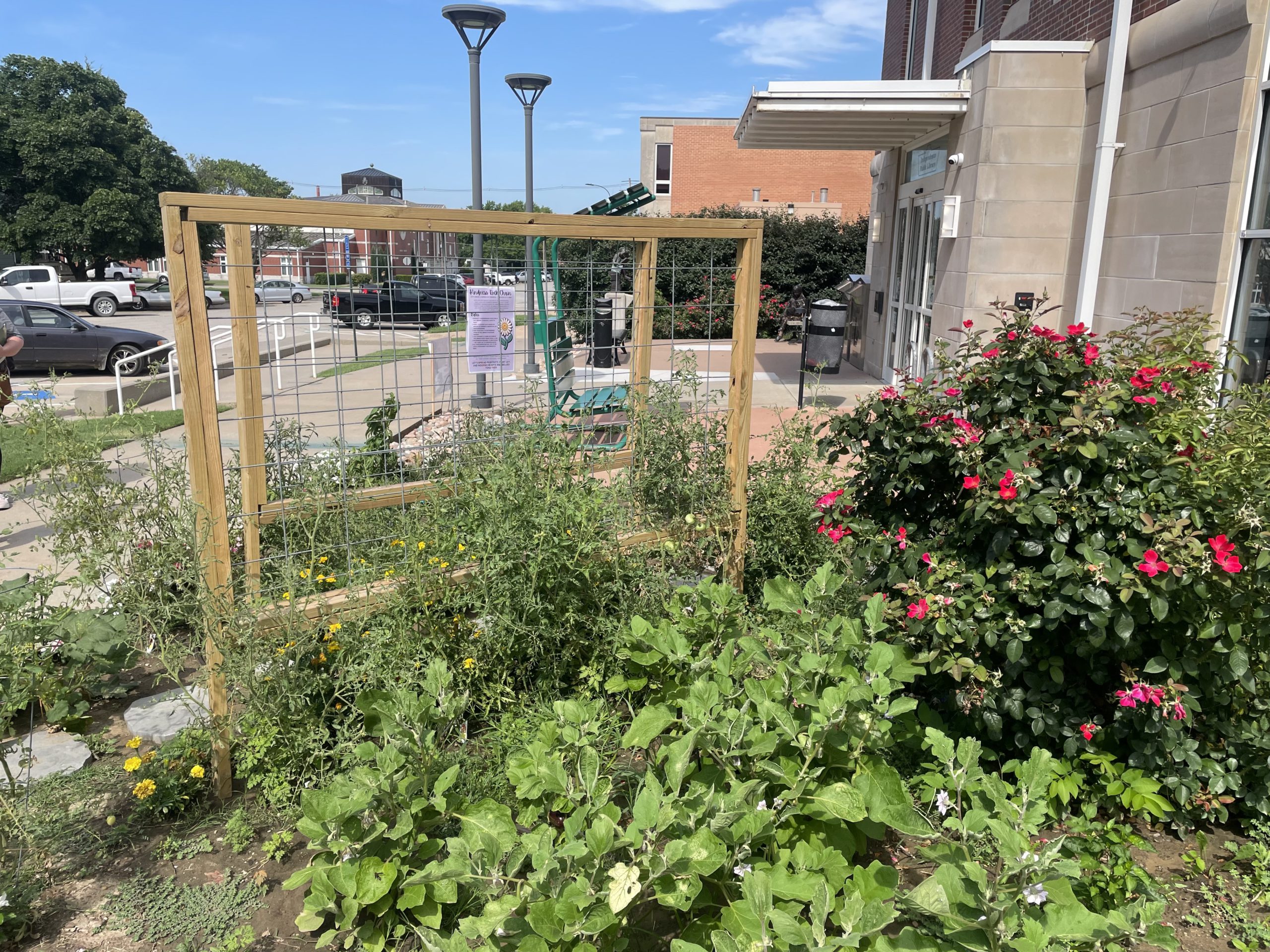
-or-
Email Brandon West, Eat, Play, Read project lead at brandon@iplks.org
Now in its third year, the Independence Public Library’s Eat, Play, Read initiative is transforming how our community grows, prepares, and shares food. Originally launched to address health disparities and food insecurity in Montgomery County—one of the most food-insecure counties in Kansas—the program empowers families with limited resources, chronic illness, or simple curiosity to build lifelong skills in gardening, cooking, and wellness. From indoor hydroponic towers to outdoor garden beds, the library is creating a vibrant learning environment where families can literally pick fresh produce, join cooking classes, and bring healthy meals home.
This work is made possible through generous grant support. In 2023, IPL was selected as one of just 46 libraries nationwide to receive funding from the Association of Rural and Small Libraries in partnership with Penguin Random House, with additional backing from ByWater Solutions’ Community Gives Back grant. These funds launched our Seed Library, expanded our gardening spaces, and introduced innovative resources like mobile cooking stations and food preservation equipment. Together, these tools ensure that families in Independence have access to both fresh food and the knowledge to prepare it.
What started as a small library program has grown into a powerful coalition of community partners. Working hand-in-hand with the K-State Extension Office, health educators, and the Independence Community Access Center, IPL has built a network of support that reaches well beyond the library’s walls. These partners contribute expertise in gardening, cooking, nutrition, and health, helping us to deliver workshops, cooking classes, and educational opportunities that serve families of all ages and backgrounds.
The initiative is growing alongside the community it serves. A natural playground and exercise area are taking shape outside the library, offering families safe spaces to play, read, and explore. New Flex Tower Gardens will provide year-round produce for the library, local food banks, and cooking classes, while resources like electric canners and food dehydrators will soon be available for checkout. By blending play, learning, and hands-on access to food, Eat, Play, Read offers a holistic approach to health and wellness that uplifts the entire community.
Everyone is invited to be part of this movement. You can check out seeds, attend a family cooking class, volunteer in the gardens, or simply stop by the library to see what’s growing and take home some fresh produce. By participating in Eat, Play, Read, you’re not only improving your own health—you’re helping build a stronger, more food-secure Independence for generations to come.
Resources
Books Available at IPL!
Kansas Garden Guide –This comprehensive (202-page) guide provides the basic knowledge for a successful garden. It was created and distributed by Kansas State University.
Kansas State University Horticulture and Natural Resources Publications – Here is a list of topics and resources produced by the horticulture, entomology, plant pathology, and Kansas Forest Service experts at Kansas State University.
K-State Free Publications:
Planning:
Starting Plants from Seed – Discover how to transplant your seeds to your garden.
Planning a Garden – Learn how to select a location, ensure the soil is correct, and select what to grow.
Good Gardening Practices – Use this checklist to ensure your garden is healthy.
Gardening on Lead-Contaminated Soils – This publication by the K-State Department of Agronomy discusses the effects of lead-contaminated soils.
Raised Bed Gardening – Discover how to plan your raised bed gardening with this resource.
Fall Vegetable Gardens – Discover how to extend your garden into the fall with this fall vegetable garden publication.
Growing:
Growing Flowers in Pots — Learn how to choose a suitable container and fertilize it to produce beautiful flower pots.
Container Gardening – Vegetable Gardens – Discover how to grow vegetables in containers.
Growing Vegetables in Pots – Learn how to grow your vegetables in pots.
Growing Herbs for Home Use – This publication teaches you about herbalism and how to grow herbs at your home.
Maintaining:
Watering Vegetable and Flower Gardens – Stay up-to-date with how to water your vegetable and flower gardens while mitigating a drought.
Insect and Mite Pests of Vegetable Gardens – This publication discusses how to mitigate pests.
Composting – Discover how to compost waste to create organic matter to improve your garden.
Harvesting and Market Gardening:
Harvest and Storage of Fruits and Vegetables – Created by Charles Marr (Extension State Leader) and Frank Morrison (Extension Horticulturist), this publication teaches you how to harvest and store the produce you grow.
Food Safety for Farmers’ Markets — Karen Gast, an Extension Horticulturist, created this guide to help those raising market gardens.
Food Sold Directly to Consumers – This publication discusses the regulations and best practices for food safety.
Alkaline: A soil with a pH between 7.0 and 14 (on a scale of 0.0-14.0). Often referred to as “sweet” soil by gardeners.
Anaerobic: Describes organisms living or occurring where there is no oxygen.
Annual: A plant that blooms, produces seed, and dies in one year.
Beneficial Insect: An insect that benefits your garden by eating or laying its eggs in other insects, thereby controlling their population.
Biennial: A plant that completes its full life-cycle in two growing seasons. It produces leaves in the first and flowers in the second.
Biodegradable: Able to decompose or break down through natural bacterial or fungal action. Substances made of organic matter are biodegradable.
Biological Pest Control: Using living organisms such as beneficial insects or parasites to destroy garden pests.
Bolt: A term used to describe a plant that has gone to seed prematurely.
Chlorosis: A yellowing or blanching of the leaves due to lack of chlorophyll, nutrient deficiencies or disease.
Cold Frame: An unheated structure usually made of wood and covered with glass or plastic. Cold frames are used to protect plants from frost and are helpful season extenders.
Companion Planting: The sowing of seeds in the garden in such a way that plants help each other grow instead of competing against each other.
Compost: Completely decayed organic matter used for conditioning soil. It is dark, odorless and rich in nutrients.
Cover Crop: Vegetation grown to protect and build the soil during an interval when the area would otherwise lie fallow.
Crop Rotation: The planting of a specific crop in a site different from the previous year.
Cutting: A vegetative method of plant propagation whereby a piece of plant leaf, stem, root or bud is cut from a parent plant. It is then inserted into a growing medium to form roots, thus developing a new plant.
Damping Off: Decay of young seedlings at ground level following fungal attack. Often the result of soil borne diseases and over watering.
Dead Heading: The act of removing spent flowers or flower heads for aesthetics, to prolong bloom for up to several weeks or promote re-bloom, or to prevent seeding.
Deep Shade: A plant requiring less than 2 hours of dappled sun a day.
Direct Seed: To seed directly into the soil instead of starting your seeds indoors.
Fertilizer: An organic or synthetic material added to the soil or the plant, that is important for its nutrient value. Want to make your own plant nutrients?
Foliar Fertilizing: A technique of feeding plants by applying liquid fertilizer directly to plant leaves.
Frost Date: This is the average expected last frost date for your area. Frost dates are important to know for your gardening zone or planting area.
Fungicides: Compounds used to prevent the spread of fungi in gardens and crops, which can cause serious damage to plants.
Germinate: The beginning of growth in seeds, the action of sprouting, budding or shooting, above the soil. This occurs whenever a plant or seed begins to vegetate into leafy young plants. The breaking of dormancy in seeds or the sprouting of pollen grains deposited on a stigma.
Green Manure: A crop that is grown and then incorporated into the soil to increase soil fertility or organic matter content. Usually turned over into the soil a few weeks before new planting begins.
Hardening Off: The process of acclimatizing plants grown under protection, in the greenhouse for example, to cooler conditions outdoors.
Harvest Time: Often listed on the seed pack, this is the amount of time it takes to be able to pick the fruit/vegetable.
Heavy Soil: A soil that contains a high proportion of clay and is poorly drained.
Humus: A fairly stable, complex group of nutrient-storing molecules created by microbes and other forces of decomposition by the conversion of organic matter. Typically its dark loamy earth.
Ideal Temperature: This is the best range of temperatures a plant will grow.
Integrated Pest Management (IPM): A pest control strategy that uses an array of complementary methods: natural predators and parasites, pest-resistant varieties, cultural practices, biological controls, various physical techniques, and pesticides as a last resort. It is an ecological approach that can significantly reduce or eliminate the use of pesticides.
Light: This is the amount of light required for the plant to thrive.
- Full sun – more than 6 hours of direct sun per day
- Part sun – 4 to 6 hours of direct sun per day, including some afternoon sun
- Part shade – 4 to 6 hours of direct sun per day, mostly before midday
- Full shade – less than 4 hours of direct sun per day
Mulch: Any organic material, such as wood chips, grass clippings, compost, straw, or leaves that is spread over the soil surface (around plants) to hold in moisture and help control weeds.
No-Till-Gardening: This type of gardening calls for no cultivation (or tilling) of the soil after the initial tilling. In its place, regular mulches are added and plants are planted through the mulch. This saves on labor and eliminates weeds, which might germinate as a result of tilling.
N-P-K: An abbreviation for the three main nutrients that have been identified as absolutely necessary for plants are nitrogen (N), phosphorus (P) and potassium (K). These three are also known as “macronutrients,” and are the source of the three numbers commonly found on fertilizer labels.
Organic: Refers to something derived from living organisms and is made up of carbon-based compounds. It is also a general term used for a type of gardening using no chemical or synthetic fertilizers or pesticides.
Organic Gardening: This method of gardening is based on building a healthy, living soil through composting and using supplemental nutrients from naturally occurring deposits. The basic principle is to feed the soil so the soil will feed the plants. Healthy plants are better able to resist pests and disease thus reducing the need for control. If control is needed, cultural and mechanical methods are used first. Naturally derived pesticides are used only as a last resort.
Perennial: A plant that grows and flowers for years. They are either evergreens or may die back to the ground but will grow again the following season.
pH: A scale from 0-14 that explains the degree of acidity or alkalinity of the water or soil. Soil pH is very important because it affects the availability of nutrients to plants and the activity of microorganisms in the soil.
Planting: This is the best time to plant a plant, and is often broken up to spring, summer, and fall.
Plant Space: Listed on the seed packet, this is how far apart or how much space is needed between plants.
Rhizome: A fleshy underground stem or runner. Creeping grasses spread by rhizomes.
Season Extender: Any technique or piece of equipment used to extend the growing season in both spring and fall. Examples include; row covers, greenhouses, hotbeds, cold frames, and products such as Wall O’ Waters.
Seed Depth: This is listed on the back of the seed packet and refers to how deep to plant a seed.
Soil Amendment: Material added to the soil to improve its properties. This may include; water retention, permeability, water infiltration, drainage, aeration and structure. Soil amendments are mostly organic matter or very slow release minerals and are typically worked into the topsoil.
Soil Test: A measurement of the major nutrients (nitrogen, phosphorous, and potassium) and pH levels in the soil.
Sprouts In: This is the time it takes for a seed to germinate, or poke through the soil.
Tilth: Describes the general health of the soil including a balance of nutrients, water, and air. Soil that is healthy and has good physical qualities is in good tilth.
Topdressing: Applying fertilizers or some kind of soil amendment after seeding, transplanting or once the crop has been established.
Transplanting: The moving of a plant from one growth medium to another.
Vermicomposting: The use of red worms to convert food scraps or other organic materials into worm castings.
Worm Casting: The digested organic waste of red worms. Gardeners consider them the most nutrient dense organic compost available.
Xeriscaping: To create a low maintenance landscape with native plants and small or non-existent areas of turf grass. One of the primary goals of xeriscaping is to reduce landscape water use.
A seed library is a unique resource where members of the community can access a diverse range of high-quality seeds for free. These libraries are often located in public libraries and community centers, providing easy access to anyone who is interested in gardening or growing their own food.
At the Independence Public Library, we are proud to have launched our very own seed library, thanks to a generous grant from ByWater Solutions. We have carefully curated a selection of seeds that includes a variety of fruits, herbs, vegetables, and native flowers.
We are committed to not only providing free seeds but also fostering a community of gardeners and healthy eaters. As such, we offer a range of free programs and events focused on gardening and healthy eating, catering to all experience levels. Whether you are a seasoned pro or a complete beginner, the IPL seed library has something for you!
Our goal is to empower our community to grow their own food and to promote a sustainable and healthy lifestyle. We believe that access to free, high-quality seeds, as well as education and support, is crucial to achieving this goal. Join us at the IPL seed library and start your gardening journey today!
How It Works!
Patrons are allowed up to five (5) packets of seeds each visit to the library.
For each visit, we ask that you put your name on the sign-up sheet and the number of packets you took.
Seed Collection
Harvest Time |
Light |
Sprouts In |
Seed Depth |
Plant Spacing |
Ideal Temp |
Planting |
|
Fruits and Veggies |
|||||||
| Beets | |||||||
| Bull’s Blood | 50 | Full Sun | 14-21 Days | 1/2 inch | 6 inches | 50-85 | Spring/Fall |
| Broccoli | |||||||
| Waltham 29 | 75 | Full Sun | 7-10 Days | 1/4 inch | 12 inches | 60-80 | Spring/Fall |
| Cabbage | |||||||
| Brunswick | 90 | Full Sun | 7-10 Days | 1/4 inch | 10 inches | 50-75 | Spring/Fall |
| Carrots | |||||||
| St. Valery | 70 | Full Sun | 12-18 Days | 1/8 inch | 3 inches | 50-75 | Spring/Fall |
| Corn | |||||||
| High Carotene | 80 | Full Sun | 7-14 Days | 1 inch | 12 inches | 85-90 | Summer |
| Cucumber | |||||||
| Sweet Market More | 63 | Full Sun | 7-14 Days | 1/2 inch | 3 inches | 75-85 | Summer |
| Green Beans | |||||||
| Blue Lake Bush 274 | 60 | Full Sun | 7-14 Days | 1/2 inch | 4 inches | 70-80 | Spring/Fall |
| Okra | |||||||
| Burmese | 56 | Full Sun | 7-14 Days | 1 inch | 18 inches | 75-90 | Summer |
| Peas | |||||||
| Lincoln Garden | 62 | Full Sun | 7-14 Days | 1 inch | 4-6 inches | 55-75 | Spring/Fall |
| Peppers, Bell | |||||||
| Ozark Giant | 75 | Full Sun | 7-10 Days | 1/4 inch | 18 inches | 70-95 | Summer |
| Peppers, Jalapeno | |||||||
| Craig’s Grande | 70 | Full Sun | 7-10 Days | 1/4 inch | 18 inches | 70-95 | Summer |
| Pumpkin | |||||||
| Pie | 90 | Full Sun | 7-14 Days | 1 inch | 48 inches | 65-95 | Summer |
| Tomato | |||||||
| Beefsteak (Slicer) | 85 | Full Sun | 7-14 Days | 1/8 inch | 24 inches | 75-90 | Summer |
| Cherry (Snack) | 65 | Full Sun | 7-14 Days | 1/8 inch | 24 inches | 75-95 | Summer |
| Martino’s Roma (Processing) | 75 | Full Sun | 7-14 Days | 1/8 inch | 24 inches | 75-95 | Summer |
| Squash | |||||||
| Fordhook Zucchini | 57 | Full Sun | 5-10 Days | 1/2 inch | 12-24 inchese | 70-95 | Summer |
| Watermelon | |||||||
| Crimson Sweet | 85 | Full Sun | 5-10 Days | 1/2-1 inch | 36 inches | 70-95 | Summer |
Leafy Greens |
|||||||
| Arugula | |||||||
| Atomic | 35 | Full Sun | 7-14 Days | 1/4 inch | 6 inches | 45-65 | Spring/Fall/Indoors |
| Collard Greens | |||||||
| Georgia Southern | 75 | Full Sun | 8-12 Days | 1/4 inch | 24 inches | 60-70 | Spring/Fall/Indoors |
| Kale | |||||||
| Russian Red | 50 | Full Sun | 6-9 Days | 1/4 inch | 8 inches | 45-85 | Spring/Fall/Indoors |
| Lettuce, Iceberg | |||||||
| Hungarian Landrace II | 85 | Full/Part | 7-10 Days | 1/4 inch | 8 inches | 45-70 | Spring/Fall/Indoors |
| Lettuce, Romain | |||||||
| Crisp Mint | 65 | Part Sun | 7-10 Days | 1/4 inch | 8 inches | 60-80 | Spring/Fall/Indoors |
| Mustard | |||||||
| Southern Giant Curled | 50 | Full Sun | 5-8 Days | 1/4 inch | 12 inches | 55-70 | Spring/Fall/Indoors |
| Spinach | |||||||
| New Zealand | 60 | Full/Part | 14-21 Days | 1/2 inch | 12 inches | 55-75 | Spring/Fall/Indoors |
Herbs |
|||||||
| Basil | |||||||
| Genovese | 60 | Full Sun | 6-10 Days | 1/4 inch | 8 inches | 70-80 | Warm/Indoor |
| Cilantro | |||||||
| 55 | Part Sun | 7-10 Days | 1/4 inch | 4 inches | 60-80 | Warm/Indoor | |
| Chives, Onion | |||||||
| Common | 60 | Part Sun | 7-14 Days | 1/8 inch | 3 inches | 55-60 | Warm/Indoor |
| Chives, Garlic | |||||||
| Chinese | 60 | Part Sun | 7-14 Days | 1/8 inch | 3 inches | 55-60 | Warm/Indoor |
| Dill | |||||||
| Elephant | 60 | Full Sun | 7-21 Days | 1/8 inch | 4 inches | 55-75 | Summer |
| Rosemary | |||||||
| Rosy | 80 | Full Sun | 14-28 Days | 0 inche | 12 inches | 80-90 | Summer/Indoor |
| Sage | |||||||
| Broad Leaf | 80 | Full Sun | 7-21 Days | 0 inche | 12 inches | 60-70 | Warm/Indoor |
Native Wild Flowers |
|||||||
| Black-Eyed Susan | 60 | Full Sun | 7-10 Days | 1/4 inch | 18 inches | 68-95 | Summer/Fall |
| Wild Bergamot | 365 | Full Sun | 14-21 Days | 0 inch | 12 inches | 60-90 | Summer |
| Coneflower, Grayhead | 365 | Full Sun | 10-15 Days | 1/8 inch | 8 inches | 65-90 | Summer |
| Coneflower, Purple | |||||||
| Purpurea Echinacea | 120 | Full Sun | 10-15 Days | 1/8 inch | 8 inches | 65-90 | Summer |
| Leavenworth Eryngo | 110 | Sun | 7-10 Days | 0 inch | 18 inches | 55-60 | Spring |
| Hopi Black Dye Sunflower | 90 | Full Sun | 7-14 Days | 1/2 inch | 18 inches | 65-75 | Summer |
| Big Flower Zinnia Mix | 70 | Full Sun | 4-6 Days | 1/4 inch | 9 inches | 70-95 | Summer |
Books Available for Check-Out!
Discover how to use the produce you grow in your kitchen with these delicious recipes!
Snap a picture of your food creation and send it to indylibrary@iplks.org for your chance to be featured on our social media.
Books Available for Check-Out at IPL!
K-State Research and Extension Resources
Canning – This resource provides the resources to understand both types of canning methods.
Dehydrating – One of the oldest methods of food preservation.
Freezing – An easy and convenient method of preserving food.
Jams and Jellies – Find a variety of jam and jelly recipes and resources.
Pickling – Discover how to pickle and find recipes to help learn.
Video Library – Discover K-State Research and Extension’s vast video library for water bath canning and pressure canning.
Recipes – K-State has curated a robust list of reputable canning sights.
Gardening How To Video’s
Find out more by subscribing to Kansas State University’s Extension YouTube Page. They have a wide range of videos to help you start your own garden.
Preserving Your Food
Canning Basics
Find out more by visiting the Kansas State Extension’s YouTube Channel!
Hydroponics
What is Hydroponics?
D.I.Y. Tower System
D.I.Y. Kratky System
What Can I Grow?
D.I.Y. Aeroponics System
D.I.Y. NFT System
The Independence Public Library is proud to be working with an amazing group of community partners! Our Eat, Play, Read partners consist of content experts, audience experts, and local farmers and gardeners. Click on each of our community partners to learn more about them!
Content Experts: Organizations with knowledge of gardening, food production, healthy meals, and nutrition.
- Independence Garden Club
- Wildcat Extension District
- Winkleman’s Garden Center
- Independence FFA Chapter
- Greenbush
Audience Experts: Organizations who work with families with limited resources.
- Independence Community Access Center
- Four County Mental Health, Project Before
- Independence Diversity Task Force
- SKIL
- Parents as Teachers
- Tree House of Early Learning
Individual Experts: Individuals who are either audience or content experts, but do not represent an organization.
Fruits and Vegetables

History:
Beets, believed to originate from the coast of the Mediterranean, specifically from what is known as Sea Beets, were first cultivated for their edible leaves. By the end of the 15th century, beets had spread throughout Europe, with records of their use for both leaves and roots. In the 1700s, Prussians developed beets containing sugar, a significant development in the beet’s history. Nowadays, sugar beets, a direct result of this development, provide almost half of the world’s sugar. Beets were most likely brought to America by European immigrants, a fact that can be traced back to the 1800s. By this time, beets had undergone a significant transformation. They were no longer white or black with pointed roots. Instead, they were these round bulbous roots with deep hues of red. This new beet is what we are familiar with today.
Companion Plants:
Beans, Broccoli, Brussels Sprouts, Cauliflower, Carrots, Catnip, Garlic, Lettuce, Marigold, Mint, Onions, & Radishes
Plant Info:
- Full Sun
- Sprouts In: 14-21 Days
- Seed Depth: ½”
- Ideal Temperature: 50-85 F
- Plant Space: 6”
- Frost Hardy: Yes
- Harvest Time: 50 Days
Growing Tips:
Plant 3-4 weeks before last frost. Once they sprout, quickly thin them out.

Waltham 29 Broccoli
Brassica oleracea
Healthy Recipes:
History:
The modern-day broccoli plant was derived from wild broccoli that grew in the Mediterranean region. Broccoli gradually spread to the rest of Europe and America. Most notably, Thomas Jefferson grew broccoli in his experimental garden. Following WWI, broccoli was grown in San Jose, California, and later shipped to Boston’s North End, expanding broccoli’s market. In 1950, however, researchers at the University of Massachusetts in Waltham, MA, developed Waltham 29 broccoli. Nowadays, broccoli is grown in almost every US state.
Companion Plants:
Beets, Bush beans, Carrots, Celery, Chard, Cucumber, Dill, Kale, Lettuce, Mint, Nasturtium, Onion family plants, Oregano, Potato, Rosemary, Sage, & Spinach
Plant Info:
- Full Sun
- Sprouts In: 7-10 Days
- Seed Depth: ¼”
- Ideal Temperature: 60-80 F
- Plant Space: 12”
- Frost Hardy: Yes
- Harvest Time: 75 Days
Growing Tips:
Start indoors in late winter, or sow seeds directly 3-4 weeks before last frost. You can plant this crop again in late summer for a Fall harvest.
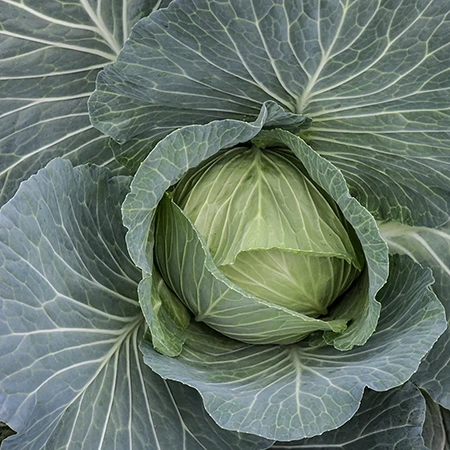
Brunswick Cabbage
Brassica oleracea
Healthy Recipes:
History:
While cabbage has a somewhat elusive history, it is believed to be domesticated in Europe around 1,000 BC. Since Antiquity, cabbage has been used in cuisine and was described as a table luxury during the Roman Empire. Cabbage is an excellent variety for late-season and cool weather. Brunswick Cabbage was first mentioned in a seed catalog in the 1870s.
Companion Plants:
Beans, Beets, Celery, Garlic, Mint, Nasturtium, Onions, Oregano, Peas, Potato, Rosemary, Sage, & Thyme
Plant Info:
- Full Sun
- Sprouts In: 7-10 Days
- Seed Depth: ¼”
- Ideal Temperature: 50-75 F
- Plant Space: 10”
- Frost Hardy: Yes
- Harvest Time: 90 Days
Growing Tips:
This crop prefers cool weather and damp soil. They can be planted for a late spring or fall harvest.

St. Valery Carrot
Daucus carota
Healthy Recipes:
History:
Carrots began being grown for crops in Central Asia (Afghanistan, Iran, & Uzbekistan) more than 1,100 years ago. Some evidence points to carrots being grown earlier than this by the Roman Empire. Carrot seeds have been found in Swiss and German campsites 3,000-5,000 years ago. However, these varieties most likely are wild seeds. Carrots come in a variety of colors. However, the Dutch developed the iconic orange carrot. The Vilmorins of France (a French Seed Producer) mentioned the St. Valery variety in 1885. They said it had been grown a “long time” then.
Companion Plants:
Beans, Cabbage, Cilantro, Dill, Lettuce, Onion, Radishes, Sage, Tomatoes, & Turnips
Plant Info:
- Full Sun
- Sprouts in 12-18 Days
- Seed Depth: 1/8″
- Ideal Temperature: 50-75 F
- Plant Spacing: 2-3″
- Frost Hardy: Yes
- Harvest Time: 70 Days
Growing Tips:
Carrots require light and fluffy soil in full sun, adequate moisture but only average fertilizing. Surface sow; press in gently and provide consistent irrigation. Best in cooler weather.

History:
Christopher Columbus first introduced this vegetable to Europe in 1493. However, the commodity did not catch on due to inadequate education on how to grow the vegetable. Sweet corn occurs spontaneously due to a mutation in field corn. Because of the genetic mutation, sweet corn has a higher sugar level in each kernel. Many Native American tribes grew corn as a source of food. The Iroquois tribe grew the first recorded crop of sweet corn, called “Papoon,” for European settlers in 1779. Since then, sweet corn has become a staple in southern food.
Companion Plants:
Annual Flowers, Beans, Cucumbers, Dill, Mint, Marigolds, Nasturtium, Peas, Radishes, Squash, Sunflowers, & Thyme
Plant Info:
- Full Sun
- Sprouts In: 7-14 Days
- Seed Depth: 1”
- Ideal Temperature: 85-90 F
- Plant Space: 12”
- Frost Hardy: No
- Harvest Time: 85 Days
Growing Tips:
Direct sow once temperatures stay above 65 degrees. You will need to plant this crop in blocks of four rows to ensure each kernel of corn gets pollinated.
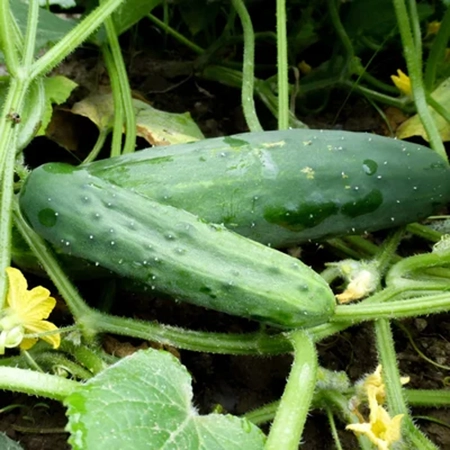
Sweet Marketmore Cucumber
Cucumis sativus
Healthy Recipes:
History:
Cucumbers originated in India and have been cultivated in Western Asia for at least 3000 years. They were first spread to Europe through Greece and Italy, appearing in France in the 9th century and England in the 14th. Christopher Columbus introduced cucumbers to Haiti in 1494. In 1535, Jacques Cartier found cucumbers growing in what would later be called Montreal. Marketmore cucumbers are a variety of cucumbers developed by Dr. Henry Munger from Cornell University in 1968. Since then, the Marketmore cucumber has been a global staple, passed down through families.
Companion Plants:
Borage, Calendula, Celery, Carrots, Corn, Dill, Melons, Nasturtium, Onion, Oregano, Peas, Potato, Radishes, Root Vegetables, & Sunflowers
Plant Info:
- Full Sun
- Sprouts In: 7-14 Days
- Seed Depth: ½”
- Ideal Temperature: 75-85 F
- Plant Space: 3”
- Frost Hardy: No
- Harvest Time: 65 Days
Growing Tips:
Direct sow after danger of last frost.

Blue Lake Bush 274 Green Beans
Phaseolus vulgaris
Healthy Recipes:
History:
Green beans, called snap beans or string beans, originated in Central and South America. Evidence shows that green beans have been cultivated in Mexico and Peru for thousands of years. The crop spread throughout the Americas due to Indigenous tribes spreading their seeds. Explorers brought green beans to North America and other countries in the late 1400s. Many varieties were pole beans, which Native Americans would plant next to corn, acting as a trellis. In the late 1800’s, they began breeding green beans to have fewer strings. 1961, the Blue Lake Bush 274 Green Bean was developed for reliability, flavor, yield, and disease resistance.
Companion Plants:
Carrots, Cucumbers, Corn, Nasturtium, & Squash
Plant Info:
- Full Sun
- Sprouts In: 7-14 Days
- Seed Depth: ½”
- Ideal Temperature: 70-80 F
- Plant Space: 4”
- Frost Hardy: No
- Harvest Time: 60 Days
Growing Tips:
Direct sow seeds after last frost. Succession plant seeds to prolong harvest. You can increase the yield by harvesting regularly. This can be an early summer and late fall crop. Soak seeds over night before planting.

History:
Okra is thought to have originated from Ethiopia and then brought to Egypt, with records showing cultivation in 1216. From Egypt, the plant spread throughout the Mediterranean before heading eastward. Okra was introduced to the South of America by enslaved African people, who were victims of the slave trade in the early 16th century. Okra was one of the few crops enslaved Africans could bring, and the crops were successfully cultivated. It became a staple of enslaved people, providing extra sustenance. By 1748, it was grown as far north as Philadelphia, and by the 1800’s, it was commonplace throughout the Southern United States.
Companion Plants:
Beans, Cucumbers, Lettuce, Melons, Peppers, & Radishes
Plant Info:
- Full Sun
- Sprouts In: 7-14 Days
- Seed Depth: 1”
- Ideal Temperature: 75-90 F
- Plant Space: 18”
- Frost Hardy: No
- Harvest Time: 56 Days
Growing Tips:
Soak seeds over night before planting. Direct sow once last frost date has passed. Pick pods while they are young and tender.

Ozark Giant Bell Pepper
Capsicum annuum
Healthy Recipes:
History:
Native to South America, the Bell Pepper (also known as Sweet Pepper, Green Pepper, or Red Pepper) is a tropical perennial but also grown as an annual. While the Bell Pepper is used as a vegetable, it is classified as a berry. Its colors range from green to yellow, orange, red, purple, black, and white. Bell peppers have been growing in Mexico since 2500 BC and spread to Europe and other parts of the world due to Christopher Columbus.
Companion Plants:
Basil, Beans, Beets, Carrots, Cilantro, Chives, Cucumbers, Crane’s-bill, Dill, Eggplant, Garlic, Lettuce, Marjoram, Marigolds Nasturtium, Okra, Onion, Oregano, Parsley, Petunia, Radishes, Spinach, & Sunflower
Plant Info:
- Full Sun
- Sprouts In: 7-10 Days
- Seed Depth: ¼”
- Ideal Temperature: 70-95 F
- Plant Space: 18”
- Frost Hardy: No
- Harvest Time: 75 Days
Growing Tips:
Start seeds 8-10 weeks before the last frost date. Ensure that seeds have bright light, and temperatures stay above 70 degrees. During the hottest part of the summer, peppers benefit from afternoon shade.
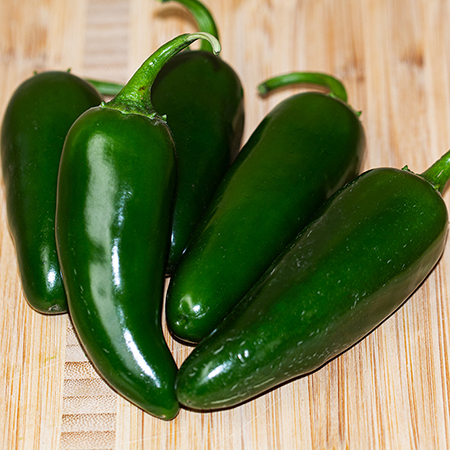
Craig’s Grande Jalapeno Pepper
Capsicum annuum
Healthy Recipes:
History:
This pepper, named after the city Jalapa, located in Veracruz, Mexico, is hot. Domesticated over 6,000 years ago, the pepper was initially used for medicinal purposes. Spanish explorers brought the pepper to the U.S. in the 16th century, when it quickly became popular in Texas and other southern states.
Companion Plants:
Beans, Carrots, Cucumbers, & Peas
Plant Info:
- Full Sun
- Sprouts In: 7-10 Days
- Seed Depth: ¼”
- Ideal Temperature: 70-95 F
- Plant Space: 18”
- Frost Hardy: No
- Harvest Time: 70 Days
Growing Tips:
Start seeds 8-10 weeks before the last frost date. Ensure that seeds have bright light, and temperatures stay above 70 degrees. During the hottest part of the summer, peppers benefit from afternoon shade.
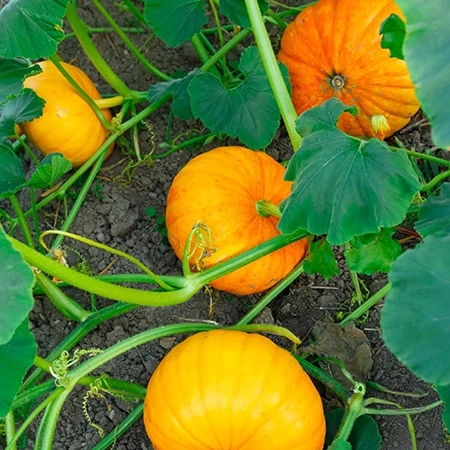
Pie Pumpkin
Cucrbita pepo
Healthy Recipes:
History:
Pumpkins are believed to have originated in North America around 9,000 years ago, with scientists dating seeds as early as 7000-5550 B.C. The word “pumpkin” originates from the Greek word “Peopon,” meaning large melon. The pumpkin has been an important staple among Native Americans, who grew them along river banks with corn and beans. This method is called the “Three Sisters” because all three plants benefit each other.
Companion Plants:
Basil, Borage, Catnip, Chamomile, Chives, Common Bean, Corn, Cucumber, Dill, Marigolds, Marjoram, Mint, Nasturtium, Oregano, Peas, Potato, Radishes, Tansy, & Tomato
Plant Info:
- Full Sun
- Sprouts In: 7-14 Days
- Seed Depth: 1”
- Ideal Temperature: 65-95 F
- Plant Space: 48”
- Frost Hardy: Light
- Harvest Time: 90 Days
Growing Tips:
Soak seeds 2-3 hours before planting. Direct sow after last frost date.
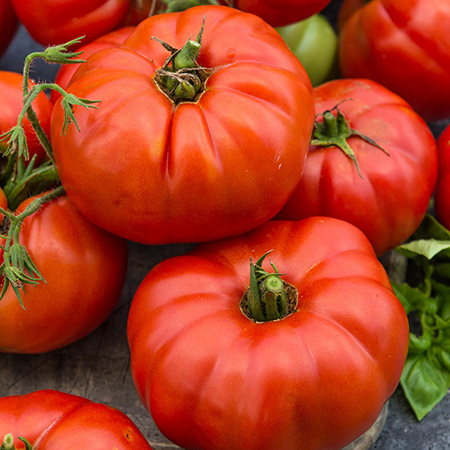
Beefsteak Tomato (Slicer)
Solanum lycopersicum
Healthy Recipes:
History:
Hundreds of years ago, tomatoes grew wild across western South America and were cultivated by indigenous people. These early cultivators eventually brought the plant northward through Central America and into Mexico. When Spanish explorers arrived in the early 16th century, they returned the tomato to Spain. By the mid-1500s, the plant had spread to Italy and become a staple in Italian cuisine. In the early 1700s, European colonists brought the tomato back to the Americas. The term “beefsteak” first appeared in an 1869 seed catalog describing the slices as “solid and meaty as a beefsteak.” It was in the 1900s that the tomato became a widespread popular fruit throughout the United States.
Companion Plants:
Asparagus, Basil, Beans, Borage, Carrots, Calendula, Chives, Cilantro, Garlic, Lettuce, Marigolds, Nasturtium, Onions, Oregano, Radishes, & Thyme
Plant Info:
- Full Sun
- Sprouts In: 7-14 Days
- Seed Depth: 1/8”
- Ideal Temperature: 75-90 F
- Plant Space: 24”
- Frost Hardy: No
- Harvest Time: 85 Days
- Indeterminate
Growing Tips:
Start seeds inside 8-10 weeks before last frost. When transplanting outside, remove all but the top two sets of leaves. Bury the entire stem to create a healthier root system.

Cherry Tomato (Snack)
Solanum lycopersicum
Healthy Recipes:
History:
The cherry tomato is believed to be the only wild tomato found outside South America. This mixture of wild and domesticated garden tomatoes ranges in size from thumbnail to golf ball. The cherry tomato is believed to have been domesticated in Puebla-Veracruz in Mexico. A Swiss botanist first referred to it in 1623, and it has been popular in the U.S. since 1919.
Companion Plants:
Asparagus, Basil, Beans, Borage, Carrots, Calendula, Chives, Cilantro, Garlic, Lettuce, Marigolds, Nasturtium, Onions, Oregano, Radishes, & Thyme
Plant Info:
- Full Sun
- Sprouts In: 7-14 Days
- Seed Depth: 1/8”
- Ideal Temperature: 75-95 F
- Plant Space: 24”
- Frost Hardy: No
- Harvest Time: 65 Days
- Indeterminate
Growing Tips:
Start seeds indoors 8-10 weeks before the last frost. Transplant outside 2 weeks after the last frost.

Martino’s Roma Tomato (Sauce)
Solanum lycopersicum
Healthy Recipes:
History:
This tomato has roots rich in Italian farming traditions and was brought to the United States through the Finger Lakes area in New York. Seed Savers first offered this tomato in 1991, and it has since been a sought-after variety. The original seeds were passed down from an 87-year-old Italian gardener, who received them from a friend from Italy many years earlier. This type of tomato, thanks to its firm, dry flesh and few seeds, makes great sauces and is ideal for canning.
Companion Plants:
Asparagus, Basil, Beans, Borage, Carrots, Calendula, Chives, Cilantro, Garlic, Lettuce, Marigolds, Nasturtium, Onions, Oregano, Radishes, & Thyme
Plant Info:
- Full Sun
- Sprouts In: 7-14 Days
- Seed Depth: 1/8”
- Ideal Temperature: 75-95 F
- Plant Space: 24”
- Frost Hardy: No
- Harvest Time: 75 Days
- Indeterminate
Growing Tips:
Start seeds indoors, and keep soil moist and at 70 degrees or warmer. Transplant outside 2 weeks after the last frost.
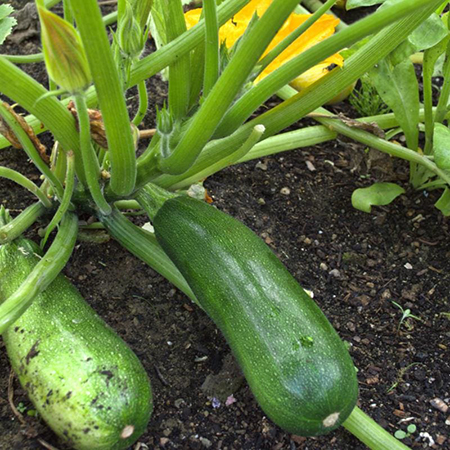
Fordhook Zucchini Squash
Cucurbita pepo
Healthy Recipes:
History:
Zucchini originated in Mesoamerica, a part of North America that extends from central Mexico to Belize, Guatemala, El Salvador, Honduras, Nicaragua, and northern Costa Rica. Christopher Columbus introduced zucchini to Europe in 1492. Zucchini took off in Italy, and in the 1800s, through selective growing, we now have a modern Zucchini. That zucchini was reintroduced to America in the early 1900s. W. Atlee Burpee Co. introduced the Fordhook Zucchini in their catalog in 1942. They obtained the seeds from a grower in Naples, Italy. Burpee continued to use selective breeding to improve on the crop, and in 1947, introduced “Fordhook Zucchini Improved.” Eventually, the word “Improved” was dropped.
Companion Plants:
Beans, Borage, Calendula, Catnip, Chamomile, Clover, Corn, Dill, Fennel, Garlic, Lavender, Lemon Balm, Marigold, Mint, Nasturtiums, Oregano, Parsley, Peas, Radishes, Spinach, Sunflowers, &Sweet Alyssum
Plant Info:
- Full Sun
- Sprouts In: 5-10 Days
- Seed Depth: 1/2”
- Ideal Temperature: 70-95 F
- Plant Space: 12-24”
- Frost Hardy: No
- Harvest Time: 57 Days
Growing Tips:
Direct sow after last frost date. If you start seeds indoors, do not let them get root bound, and try not to disturb the roots when transplanting. Harvest frequently!

Crimson Sweet Watermelon
Citrullus vulgaris
Healthy Recipes:
History:
Watermelon seeds were discovered at an archaeology site in southwestern Libya, dating back over 5000 years. Scientists believe watermelons were initially cultivated for their high water content and were stored during dry months in Africa. In the 7th century, they began being grown in India before reaching China in the 10th century. Watermelons began appearing in Europe in the 1600s and became a minor garden crop in the 17th century. European colonists and enslaved African people brought watermelon to America. As early as 1576, Spanish settlers in Florida were growing watermelons. Following the Civil War, watermelons began being grown across the states. Charles V. Hall of Kansas State University developed the Crimson Sweet Watermelon. This 1964 All-American Selection Winner is today’s most popular watermelon thanks to its high sugar content, deep red flesh, and easy handling.
Companion Plants:
Basil, Beans, Corn, Cowpeas, Cucumbers, Lettuce, Marigolds, Nasturtium, Onions, Sunflower, & Radishes
Plant Info:
- Full Sun
- Sprouts In: 5-10 Days
- Seed Depth: ½-1”
- Ideal Temperature: 70-95 F
- Plant Space: 36”
- Frost Hardy: No
- Harvest Time: 85 Days
Growing Tips:
Direct sow seeds in moist, rich soil once the cool weather has passed.
Leafy Greens

Atomic Arugula
Eruca vesicaria ssp. sativa
Healthy Recipes:
History:
This leafy green vegetable comes from the Mediterranean region. Arugula has a long history, with mention in the Old Testament, Book of Kings (II Kings 4:39), it is an old salad leaf. It is noted as being harvested for food as early as the 6th century B.C. and was even mentioned as being used as a form of Viagra, or aphrodisiac. Arugula was brought to America by British colonists and has risen and fallen throughout history in popularity. In the 1990s, thanks to foodie culture, arugula was once again popular.
Companion Plants:
Beans, Borage, Carrot, Celery, Chamomile, Chives, Cucumber, Dill, Kale, Lettuce, Rosemary, Spinach, & Strawberry
Plant Info:
- Full Sun
- Sprouts In: 7-14 Days
- Seed Depth: ¼”
- Ideal Temperature: 45-65 F
- Plant Space: 6”
- Frost Hardy: Yes
- Harvest Time: 35 Days
Growing Tips:
Start directly sowing in early spring, and continue to sow every two weeks until the first of May.
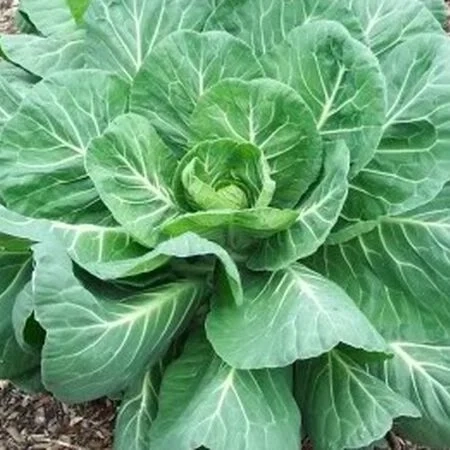
Georgia Southern or Creole Collards
Brassica oleracea var. tronchuda
Healthy Recipes:
History:
Collard greens date back to prehistoric times and are the oldest leafy green within the cabbage family. They originated near Greece in the Mediterranean and were cultivated more than 2,000 years ago. Enslaved people in Hanover County, VA, first called them “Collerds,” and were allowed to grow them in their gardens. World War I saw a decline in the number of varieties grown in the U.S. due to the large numbers of individuals moving from rural communities to cities, leaving only five varieties commonly in cultivation. In the early 2000s, a project to preserve uncommon varieties of Collards began to enable more varieties to return to cultivation.
Companion Plants:
Beets, Bush Beans, Celery, Chamomile, Cucumber, Dill, Garlic, Marigolds, Mint, Nasturtium, Onions, Potatoes, Rosemary, Sage, & Thyme.
Plant Info:
- 6-12 hours of Sun
- Sprouts in 6-9 Days
- Ideal Temperature: 45-85 Degrees F
- Seed Depth: 1/4″
- Plant Spacing: 8″
- Frost Hardy: Yes
Growing Tips:
Best grown in frosts of spring or fall. Direct seed or transplant 2-4 weeks in spring or 8 weeks in fall before frosts dates. Prefers rich soil.

Russian Red Kale
Brassica oleracea var. sabellica
Healthy Recipes:
History:
Like many leafy green vegetables, kale originated in the eastern Mediterranean, where it was cultivated for food as early as 2000 BC. Kale migrated to Western Europe in the 13th century in the cabbage family. In the 14th century, England records distinguished hard-heading cabbage and loose-leaf kale. Russian traders introduced kale in Canada and the U.S. in the 19th century. In the U.S. during the 20th century, it was mainly used as decoration. Still, it is becoming more popular as an edible vegetable due to its nutritional value.
Companion Plants:
Allium, Beans, Beets, Buckwheat, Catnip, Celery, Cilantro, Cucumber, Dill, Garlic, Leeks, Marigolds, Mint, Nasturtium, Onions, Peas, Radishes, & Sweet Alyssum
Plant Info:
- Full Sun
- Sprouts In: 6-9 Days
- Seed Depth: ¼”
- Ideal Temperature: 45-85 F
- Plant Space: 8”
- Frost Hardy: Yes
- Harvest Time: 50 Days
Growing Tips:
Best grown in spring or fall and prefer rich soil.

Hungarian Landrace II Lettuce
Lactuca sativa
Healthy Recipes:
History:
Lettuce was first grown in ancient Egypt for its oil from seeds. Through selective breeding, Egyptians began growing plants with edible leaves as early as 2680 BC. In ancient Egyptian times, the plant was considered a sacred plant of Min, a god of fertility and harvest. Iceberg lettuce became a preferred crop in America in the late 1800s due to its perfect tight head and ability to grow in the chilly spring weather or heat of the summer. It rose to popularity due to its ability to travel over long distances. Lettuce would be packaged onto train cars and shipped across the nation. In the 1920s, Fresh Express would ship lettuce using ice from California to the East Coast. When the train would pull into each stop, folks would call out, “the icebergs are coming…” The name stuck. However, the Burpees Seed catalog also mentions Iceberg Lettuce as early as 1893.
Companion Plants:
Asparagus, Basil, Beans, Beets, Calendula, Carrots, Chervil, Chives, Cilantro, Corn, Cucumbers, Dill, Eggplant, Garlic, Onion, Parsnips, Peas, Radish, Spinach, Strawberry, & Turnips
Plant Info:
- Full Sun
- Sprouts In: 7-10 Days
- Seed Depth: ¼”
- Ideal Temperature: 45-75 F
- Plant Space: 8”
- Frost Hardy: Yes
- Harvest Time: 50 Days
Growing Tips:
Direct seed, by planting at least three seeds every two inches. Once sprouted, thin to one plant per foot. This crop can be extended by sowing seeds every 10-14 days.

Crisp Mint Lettuce
Lactuca sativa
Healthy Recipes:
History:
Some of the earliest cultivated lettuce in ancient Egypt was passed to the Greeks, who shared it with the Romans. During medieval times, lettuce was used as a medicinal herb. Christopher Columbus brought Romaine or Cos lettuce from Europe to the Americas in the late 15th century. The 16th, 17, and 18th centuries saw a boom in different varieties being developed in Europe. In the late 19th century, documentation shows between 65 and 140 distinct varieties of lettuce, and each array often changes names significantly from country to country.
Companion Plants:
Asparagus, Basil, Beans, Beets, Calendula, Carrots, Chervil, Chives, Cilantro, Corn, Cucumbers, Dill, Eggplant, Garlic, Onion, Parsnips, Peas, Radish, Spinach, Strawberry, & Turnips
Plant Info:
- Full Sun
- Sprouts In: 7-10 Days
- Seed Depth: ¼”
- Ideal Temperature: 60-80 F
- Plant Space: 8”
- Frost Hardy: Yes
- Harvest Time: 65 Days
Growing Tips:
Best grown as a spring or fall crop. When planting you can sow thick rows for baby greens, or space further apart for head lettuce.

Southern Giant Curled Mustard
Brassica juncea
Healthy Recipes:
History:
Mustard is native to India, and in 2021, a study concluded that the species may have been domesticated as long as 6,000 years ago in Central Asia. Mustard has been used in Africa and China for thousands of years. Before the Silk Road began moving spices from the Orient in the 1400s, mustard was one of the only spices that could be locally grown in Europe, and it has been for at least 2,000 years. European courts employed “mustardarius,” a full-time position whose sole job was to produce mustard for the table.
Companion Plants:
Celery, Chamomile, Corn, Dill, Garlic, Mint, Onions, Rosemary, Sage, & Thyme
Plant Info:
- Full Sun
- Sprouts In: 5-8 Days
- Seed Depth: ¼”
- Ideal Temperature: 55-70 F
- Plant Space: 12”
- Frost Hardy: Yes
- Harvest Time: 50 Days
Growing Tips:
Sow in place, and preforms best during cool spring and fall conditions. However, Southern Giant Curled Mustard can tolerate heat and frost.
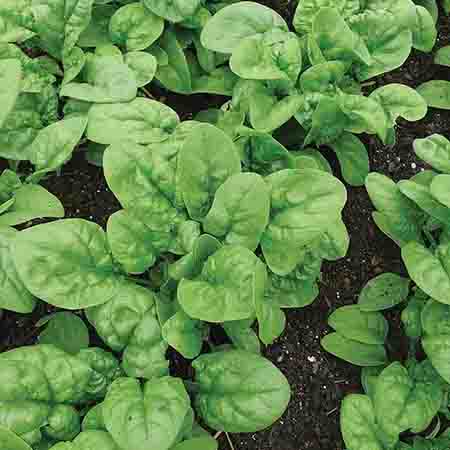
Bloomsdale Long Standing Spinach
Spinacia oleracea
Healthy Recipes:
History:
Spinach was cultivated in Iran more than 2,000 years ago, and the word “spinach” is derived from the Persian word for “green hand.” In the 1400s, spinach was grown in Europe and brought with the first settlers to America. American seed catalogs began listing spinach by 1806. Bloomsdale Long Standing Spinach was developed in 1826 by D. Landreth & Sons Seed Company in Philadelphia.
Companion Plants:
Beans, Borage, Broccoli, Carrots, Cauliflower, Collard, Cucumbers, Eggplant, Kale, Lettuce, Marigold, Nasturtium, Onion, Pea, Radish, Strawberry, Squash, Tomato,
Plant Info:
- Full Sun
- Sprouts In: 7-14 Days
- Seed Depth: ½”
- Ideal Temperature: 45-75
- Plant Space: 6-8”
- Frost Hardy: Yes
- Harvest Time: 50
Growing Tips:
Begin sowing in late winter, early spring. Plant in rich, well-draining soil with ample moisture. This is a cool weather crop, and bolts during hot summer days and dry conditions.
Herbs

Genovese Basil
Ocimum basilicum
Healthy Recipes:
History:
This form of Basil is the most famous type of Basil. It is also known as heirloom, Italian, or traditional. Genovese Basil is part of the mint family. It is associated with Italy, but it originated in areas of Asia and Africa. Humans have cultivated Basil since prehistoric times. It was brought to the Mediterranean area via the ancient spice routes. It was grown in the Liguria region of Italy by the Romans, who used it as a spread on bread. It gets its name from the port city of Genoa. Genovese Basil was brought to the U.S. by the early colonists and was an essential spice for American cuisine.
Companion Plants:
Asparagus, Beets, Borage, Broccoli, Cabbage, Carrots, Chamomile, Chives, Cucumber, Dill, Garlic, Lettuce, Marigolds, Nasturtium, Oregano, Parsnips, Potato, & Rosemary
Plant Info:
- Full Sun
- Sprouts In: 6-10 Days
- Seed Depth: ¼”
- Ideal Temperature: 70-80 F
- Plant Space: 8”
- Frost Hardy: No
- Harvest Time: 60
Growing Tips:
Basil prefers heat, and thrives all summer long. You should start your basil indoors and transplant after the danger of frost is gone. To ensure busy, abundant plants, pinch off any flowers or buds. You will also want to clip new growth back to the fork to help ensure the plant spreads wider, rather than taller.
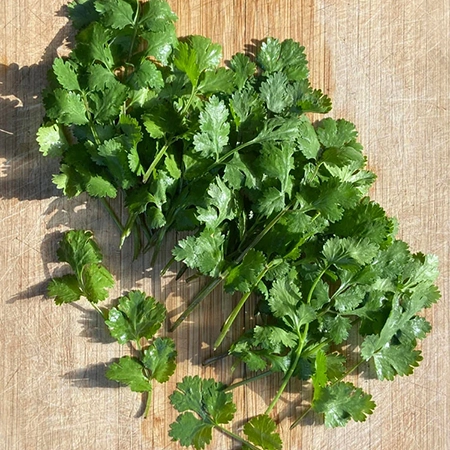
Georgian Landrace Cilantro
Coriandrum sativum
Healthy Recipes:
History:
Is it Cilantro or coriander? Cilantro is the leaves, whereas the spice coriander comes from the seeds. Egyptians grew one of the oldest known herbs, and archeologists have discovered seeds in Egyptian tombs. Archeologists discovered Cilantro in the Nahal Hemar cave in Israel, which points to it being used as early as 6,000 BC. Christopher Columbus brought Cilantro to the Americas via the Columbian Exchange, a process by which commodities, people, and diseases crossed the Atlantic. Once Cilantro was introduced to the southern reaches of the New World, it became entrenched in Central and South American cuisines. It made its way to America a century and a half later via the British colonists, who were introduced to it by the Romans.
Companion Plants:
Anise, Basil, Carrots, Chervil, Cosmos, Coreopsis, Dill, Green Beans, Legumes, Lupine, Mint, Parsley, Potato, Spinach, Sunflowers, Sweet Alyssum, Tomato,
Plant Info:
- Part Sun
- Sprouts In: 7-10 Days
- Seed Depth: ½”
- Ideal Temperature: 60-80 F
- Plant Space: 4”
- Frost Hardy: Yes
- Harvest Time: 28 Days
Growing Tips:
Plant cilantro in the cool months, and in warmer months protect it with afternoon shade. Cilantro prefers cool climates, with well-draining soil.
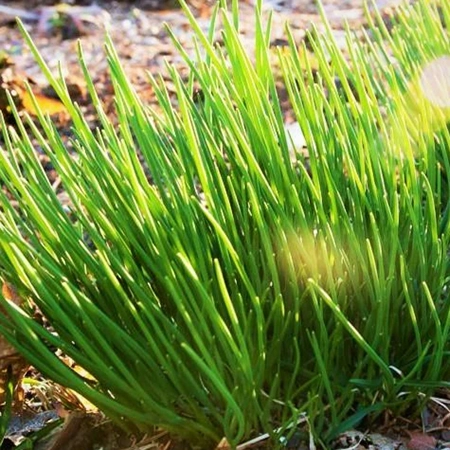
Onion Chives
Allium schoenoprasum
Healthy Recipes:
History:
Chives have been used since 3000 BC and are grown wild in Asia, Europe, Australia, and North America. The ancient Romans believed the strong-tasting chive would give physical strength and fed them to racehorses, wrestlers, and workers to strengthen them. Many cultures believed that chives had healing properties. Marco Polo brought chives to Europe from China in the late 13th century. In the US, chives are primarily used for culinary and ornamental gardening.
Companion Plants:
Allium, Basil, Broccoli, Cabbage, Carrot, Cucumber, Dill, Grapes, Marigold, Oregano, Parsley, Rose, Sage, Strawberry, & Tomato
Plant Info:
- Part Sun
- Sprouts In: 7-10 Days
- Seed Depth: 1/8”
- Ideal Temperature: 55-60 F
- Plant Space: 3”
- Frost Hardy: Yes
- Harvest Time: 60 Days
Growing Tips:
During germination, keep seeds moist at all times. Set seedlings outside after the last frost date in the spring. You may also direct sow seeds after the last frost date.

Garlic Chives
Allium tuberosum
Healthy Recipes:
History:
Chives have a long history of multiple uses. Garlic Chives have white flowers in the summer, whereas Common (Onion) chives have purple flowers. An old British tradition was to use chives in the garden or hang them over the doorway of a home to prevent evil spirits from entering. The Dutch used chives in their cow pastures to obtain chive-scented milk for cheese. Romanian Gypsies even used chives in fortune-telling. This herb is an excellent perennial for any home culinary dabbler.
Companion Plants:
Allium, Basil, Broccoli, Cabbage, Carrot, Cucumber, Dill, Grapes, Marigold, Oregano, Parsley, Rose, Sage, Strawberry, & Tomato
Plant Info:
- Sprouts In: 7-14 Days
- Seed Depth: 1/8”
- Ideal Temperature: 55-60 F
- Plant Space: 3”
- Frost Hardy: Yes
- Harvest Time: 60
Growing Tips:
During germination, keep seeds moist at all times. Set seedlings outside after the last frost date in the spring. You may also direct sow seeds after the last frost date.
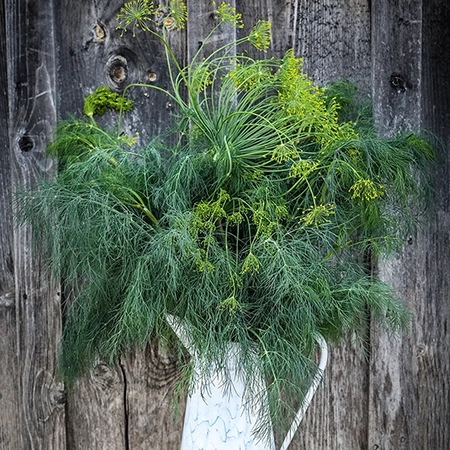
Elephant Dill
Anethum graveolens
Healthy Recipes:
History:
Like many edible plants, Dill has its beginnings in the Mediterranean region. It has a long history of use, including culinary and medicinal uses. The earliest record of Dill as a medical herb was found in Egypt over 5,000 years ago. It was referred to as a “soothing medicine.” Babylonians grew Dill in their gardens in 3,000 BC. The Greeks used the oil to burn, to make wine, and to aid with healing wounded soldiers. The herb became popular in England during the seventeenth century, and early settlers were thought to bring it with them. John Winthrop, an English Puritan, was known to have grown Dill in his garden.
Companion Plants:
Asparagus, Basil, Beans, Brussels Sprouts, Broccoli, Cabbage, Cauliflower, Carrots, Cilantro, Corn, Cucumber, Eggplant, Kale, Marigolds, Mint, Nasturtium, Onions, & Peppers
Plant Info:
- Full Sun
- Sprouts In: 7-21 Days
- Seed Depth: 1/8”
- Ideal Temperature: 55-75 F
- Plant Space: 4”
- Frost Hardy: Yes
- Harvest Time: 60
Growing Tips:
Elephant Dill prefers well drained, poor soil. You may harvest leaves as you need them or wait until the seeds form on the top 3-4-foot plant and cut the entire plant down. Dill often reseeds itself.
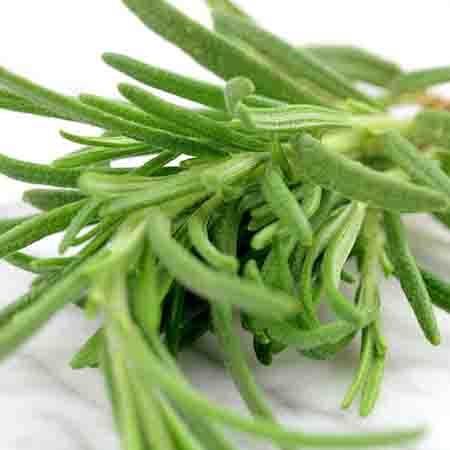
Rosy Rosemary
Salvia rosmarinus
Healthy Recipes:
History:
Native to the dry, rocky areas of the Mediterranean, this herb’s Latin name translates to “dew of the sea.” The early Greeks and Romans used it. Greek scholars often wore a garland of Rosemary on their heads to help their memory during examinations. Historical leaders like Charlemagne and Napoleon used Rosemary, and even Shakespeare mentioned the herb in five of his plays. It was cultivated in Spain during the 13th century when it was a popular condiment for salted meat. In the 14th century, Rosemary was used in the first alcohol-based perfumes in Europe. It finally arrived in the Americas when early European settlers arrived in the 17th century.
Companion Plants:
Alyssum, Basil, Beans, Borage, Broccoli, Cabbage, Carrot, Chives, Cucumber Lavender, Marigold, Marjoram, Mint, Onion, Oregano, Parsley, Sage, Straberry, Tomato
Plant Info:
- Full Sun
- Sprouts In: 14-28 Days
- Seed Depth: 0”
- Ideal Temperature: 80-90
- Plant Space: 12”
- Frost Hardy: Yes
- Harvest Time: 80
Growing Tips:
When planting rosemary, cover seed try with plastic wrap or humidity dome and keep the soil temperature at 80 F. Ensure the container has plenty of light, and that seeds are sown thickly due to low germination rates.

Broad Leaf Sage
Salvia officinalis
Healthy Recipes:
History:
Broad Leaf Sage has been used for various purposes throughout history, such as warding off evil, increasing women’s fertility and treating snakebites. The Romans considered it a “holy herb” and incorporated it into their religious practices. During the Middle Ages, Charlemagne recommended growing it in monastery gardens as it was known for its healing properties and value. Today, this trendy plant continues to be used for its therapeutic benefits.
Companion Plants:
Beans, Cabbages, Carrots, Cauliflower, Cucumber, Nasturtium Oregano, Pea, & Tomato
Plant Info:
- Full Sun
- Sprouts In: 7-21 Days
- Seed Depth: 0”
- Ideal Temperature: 60-70 F
- Plant Space: 12”
- Frost Hardy: Yes
- Harvest Time: 80
Growing Tips:
Sow the seeds on the surface, barely covering the seeds. Sage is best started indoors and transplanted outdoors after last frost. You can also directly sow seeds outdoors around the last frost. Once sage begins to grow, you should cut back the plant occasionally to ensure bushier growth.

